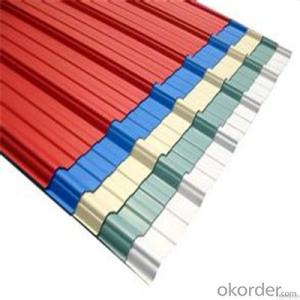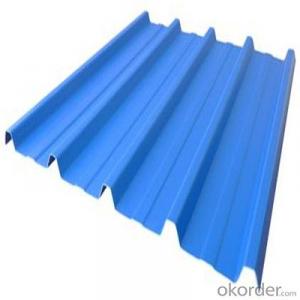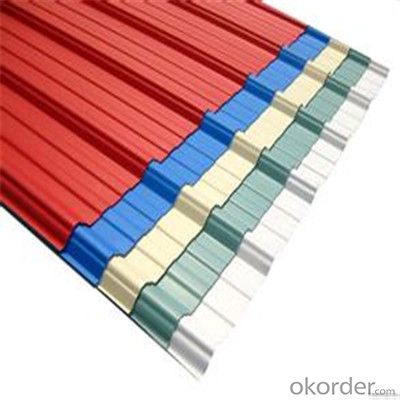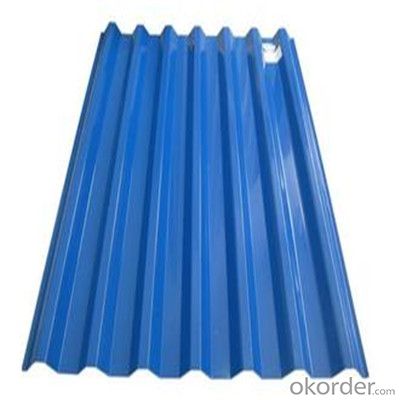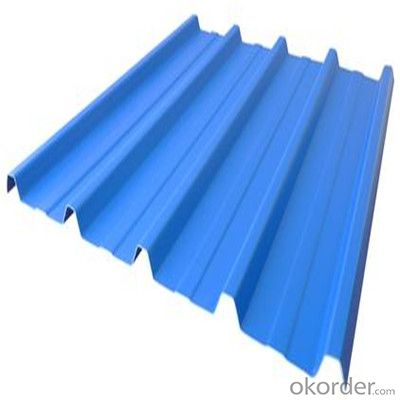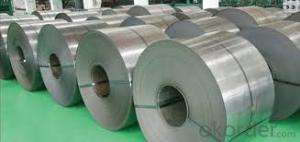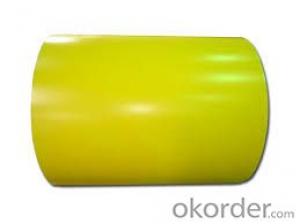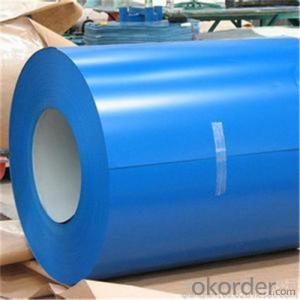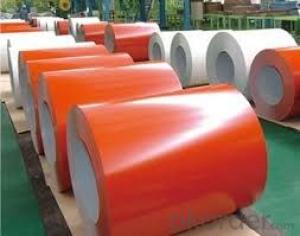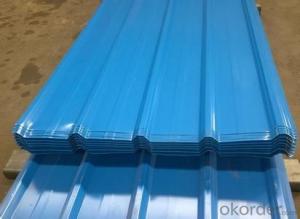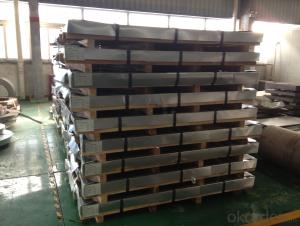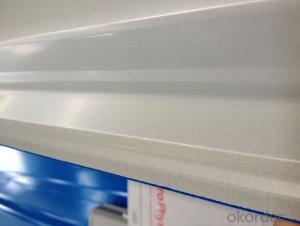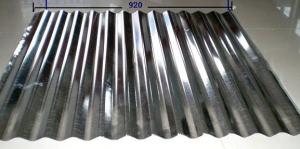Prepaint Galvanized Corrugated Iron Sheet Supplied from China
- Loading Port:
- Shanghai
- Payment Terms:
- TT OR LC
- Min Order Qty:
- 100 m.t.
- Supply Capability:
- 1000000 m.t./month
OKorder Service Pledge
OKorder Financial Service
You Might Also Like
Specification
Description of Corrugated Iron Sheet:
1. Hot-dipped galvanized
2. Color: All RAL color
3. Thickness: 0.23-1.0MM
4. Developed Width: 600mm to1200mm
Specifications of Corrugated Iron Sheet:
Standards: GB, JIS3312 and ASTM
Materials: SGCC, Q195-Q235B, SPCC, DC01, DX51D+Z and more
Thicknesses: 0.23-1.0MM
Widths: 600-1200mm
Zinc coating: 80 to 275g/m²
Features of Corrugated Iron Sheet:
Spangle: minimized spangle, zero spangle, regular spangle and big spangle
Surface treatments: Passivated (chromatic), oiled or HDG anti-finger treatment
Applications: industrial buildings, public buildings, storehouse halls, residential buildings, trade buildings, sport halls, exhibition buildings and offices
Images of Corrugated Iron Sheet:
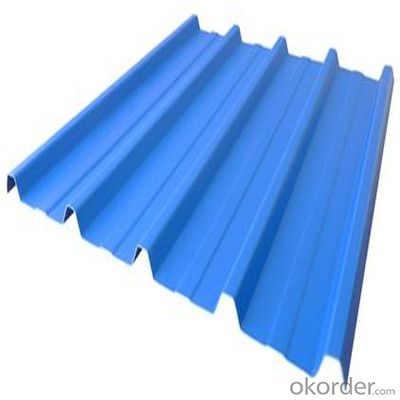
FAQ:
1. What's the Delivery port?
The main ports are Qingdao and Tianjin, we also can deliver to other ports to meet your requirements
2. How long is the lead time?
Delivery time: 45 days after order confirmed.
3. What payment term do you accept?
Payment: T/T or L/C at sight.
- Q: What is the maximum size of steel sheets available?
- The maximum size of steel sheets available can vary depending on the manufacturer and specific requirements. However, commonly available steel sheets can range in size from 4 feet by 8 feet (1.2 meters by 2.4 meters) to larger dimensions such as 10 feet by 20 feet (3 meters by 6 meters).
- Q: Can the steel sheets be used for elevator interiors?
- Certainly, elevator interiors can indeed utilize steel sheets. Steel, being a durable and versatile material, finds widespread usage in elevator construction. It imparts a sleek and contemporary appearance to elevator interior designs, which can be tailored to suit diverse styles and aesthetics. Furthermore, steel sheets are effortlessly cleaned and maintained, making them a highly practical option for elevator interiors.
- Q: Can steel sheets be used in medical applications?
- Yes, steel sheets can be used in medical applications. They are often used in the manufacturing of medical instruments, surgical tools, and equipment due to their durability, corrosion resistance, and ability to be sterilized.
- Q: What is hot and cold rolled steel plate? How to distinguish? What high hardness? Which will produce noisy eye?
- By definition, ingot or billet is difficult to deform under normal temperature, easy processing, generally heated to 1100 to 1250 DEG C for rolling, the rolling process of hot rolled steel rolling. Most are called hot method. But because the surface under high temperature steel is easy to produce iron oxide, the surface roughness of hot rolled steel, size fluctuation so large, smooth surface, precise size, good mechanical properties of the hot rolled steel, semi-finished or finished products and raw materials for the production of cold rolling method. Under normal temperature, generally understood as cold, from the metal science point of view, the boundaries of cold rolling and hot rolling should be differentiated by the recrystallization temperature is lower than rolling recrystallization. The temperature is higher than the recrystallization temperature of cold rolling, rolling for hot rolled steel. The recrystallization temperature is 450 ~ 600 degrees. The difference: the simple point that 1, cold rolled plate surface has a certain gloss hand feels smooth, Similar to that used for drinking water is very common, such as hot rolled.2 steel cup without pickling treatment, is on the market and many are similar to ordinary steel plate surface, rusty surface is red, the surface of the rusty purple black (iron oxide).The performance advantages of cold rolled plate and strip is: 1, high precision, cold rolled strip thickness not more than 0.01~0.03mm.2, thinner, cold rolled steel strip rolling thickness 0.001mm hot rolling; now the thin can reach 0.78mm.3, the surface quality is more superior, cold rolled steel plate can even produce mirror surface; and the surface of hot rolled plate there are defects such as pitting of iron oxide,.4, cold rolled plate can be adjusted according to the running properties such as tensile strength and technological properties such as stamping performance requirements of the user.
- Q: How are steel sheets protected during storage in warehouse facilities?
- Steel sheets are protected during storage in warehouse facilities through various measures such as applying protective coatings, using moisture-resistant packaging, implementing proper stacking and handling techniques, and maintaining controlled temperature and humidity levels to prevent corrosion and damage.
- Q: What are the different sheet metal bending techniques for steel sheets?
- There are several sheet metal bending techniques for steel sheets, including air bending, bottoming, coining, and folding. Air bending involves applying force to the sheet metal to bend it using a V-shaped punch and a V-shaped die, without touching the bottom of the die. Bottoming involves bending the sheet metal until it comes into full contact with the bottom of the die, resulting in a tighter bend radius. Coining is a precision bending technique that uses a punch and a die to create a highly accurate and crisp bend. Folding, on the other hand, involves bending the sheet metal at a specific angle using a press brake or a folding machine. These techniques offer various options for achieving different bending requirements in steel sheet fabrication.
- Q: What is the difference between a standard and high-strength steel sheet?
- The difference between a standard and high-strength steel sheet lies in their respective mechanical properties and performance characteristics. Standard steel sheets are often made from low to medium carbon steel, typically with a yield strength of around 250 MPa (megapascals). These sheets are commonly used in applications that do not require extreme strength or resistance to deformation. On the other hand, high-strength steel sheets are manufactured with a higher carbon content and alloying elements such as manganese, chromium, or nickel. This composition enables them to have significantly higher yield strengths, ranging from 350 to 1,000 MPa or even more. As a result, high-strength steel sheets offer enhanced resistance to deformation, higher tensile strength, and improved durability. Due to their superior mechanical properties, high-strength steel sheets are often selected for applications that demand increased strength-to-weight ratios, such as automotive components, structural parts, and heavy machinery. These sheets can withstand higher loads, endure extreme conditions, and provide better protection in case of impact or sudden forces. While standard steel sheets are more readily available and less expensive, high-strength steel sheets are preferred in situations where superior strength and performance are necessary. However, it is important to note that high-strength steel sheets may be more challenging to form, weld, or machine due to their increased hardness. Therefore, careful consideration of the specific application requirements is crucial when choosing between standard and high-strength steel sheets.
- Q: How can steel sheets be protected from rusting?
- There are various methods available to protect steel sheets from rusting. One common approach involves applying a protective coating on the surface of the steel. This can be achieved by using a corrosion-resistant paint or employing a galvanizing process. In the galvanization process, a layer of zinc is applied to the steel sheets, acting as a barrier against moisture and preventing direct contact with oxygen and water. Consequently, the risk of rust formation is reduced. Another effective method to prevent rusting is the use of corrosion inhibitors. These inhibitors can be added to the water or oil used for cooling or lubricating the steel sheets. By doing so, a protective film is formed on the surface, acting as a barrier against corrosion. Proper maintenance and storage of steel sheets are crucial in preventing rust formation. It is important to keep the sheets in a dry environment and avoid exposing them to moisture and harsh chemicals. By following these practices, the lifespan of the steel sheets can be extended, and rusting can be prevented. Additionally, opting for stainless steel sheets is another effective way to avoid rusting. Stainless steel contains a high amount of chromium, which forms a passive protective layer on the surface. This layer acts as a shield against corrosion, thereby preventing rust formation. In conclusion, protecting steel sheets from rusting requires a combination of protective coatings, corrosion inhibitors, proper storage, and maintenance. By implementing these measures, the durability and functionality of the steel sheets can be significantly extended.
- Q: How long do steel sheets last?
- Steel sheets can last for many years, often surpassing the lifespan of other materials. The longevity of steel sheets depends on various factors such as the quality of the steel, the conditions it is exposed to, and how well it is maintained. In general, high-quality steel sheets that are properly installed and maintained can last for several decades or even longer. However, if steel sheets are exposed to harsh environments, such as extreme temperatures, humidity, or corrosive substances, their lifespan may be reduced. Regular inspections, cleaning, and maintenance can help extend the lifespan of steel sheets and ensure their durability over time.
- Q: Are the steel sheets easy to maintain?
- Steel sheets are typically easy to maintain, as they possess durability and corrosion resistance, thus necessitating minimal upkeep. A simple cleaning using mild detergent and water usually suffices to keep them looking pristine and shiny. Moreover, steel sheets eliminate the need for painting or staining, further diminishing maintenance demands. In situations involving scratches or minor damages, repairs or buffing can be effortlessly executed. All in all, steel sheets are an excellent choice for diverse applications, requiring little maintenance.
Send your message to us
Prepaint Galvanized Corrugated Iron Sheet Supplied from China
- Loading Port:
- Shanghai
- Payment Terms:
- TT OR LC
- Min Order Qty:
- 100 m.t.
- Supply Capability:
- 1000000 m.t./month
OKorder Service Pledge
OKorder Financial Service
Similar products
Hot products
Hot Searches
Related keywords
